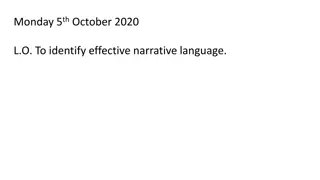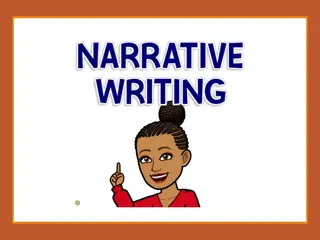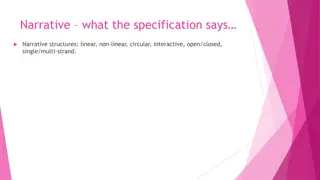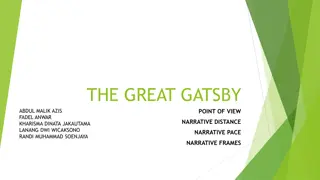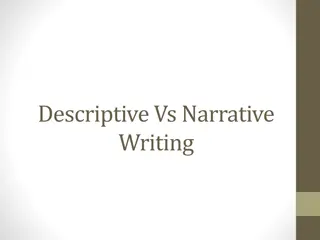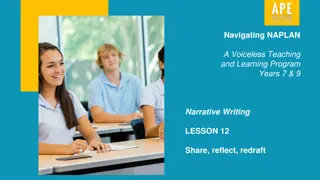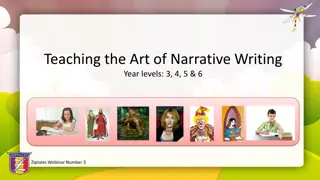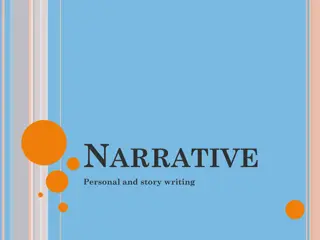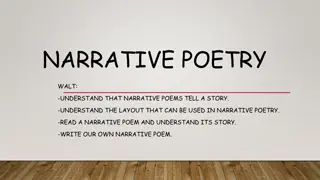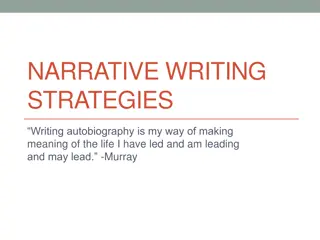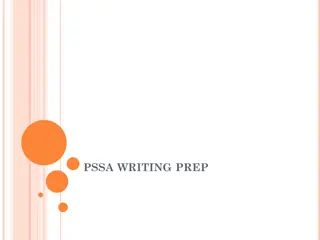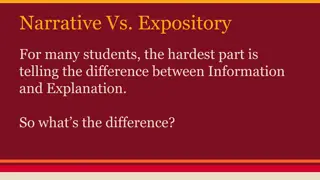Exploring Narrative Techniques for Representing Time in Writing
Explore the fundamental methods of narrating time in writing, including scene, summary, sequential summary, circumstantial summary, flashbacks, and non-linear narrative structures. Learn how writers transition between summary and scene, manipulate time, and craft engaging story arcs. Delve into examples from Margaret Atwood's works and insights on non-linear storytelling from James Baldwin's "Sonny's Blues."
Download Presentation

Please find below an Image/Link to download the presentation.
The content on the website is provided AS IS for your information and personal use only. It may not be sold, licensed, or shared on other websites without obtaining consent from the author. Download presentation by click this link. If you encounter any issues during the download, it is possible that the publisher has removed the file from their server.
E N D
Presentation Transcript
NARRATIVE TIME & THEME
METHODS FOR NARRATING TIME The basic building-blocks of narrative are SCENE and SUMMARY. Both are necessary. A scene deals at length with a short period of time. A summary covers a long period of time relatively quickly. The basic kind of summary are SEQUENTIAL and CIRCUMSTANTIAL. Sequential summary compresses time. Circumstantial summary quickly describes how things generally go. (Burroway, pp. 181-183)
Sequential Summary: The snow finally changed to slush and then to water, which trickled down the hill of the bridge in two rivulets, one on either side of the path; the path itself turned to mud. The bridge was damp, it smelled rotten, the willow branches turned yellow, the skipping ropes came out. It was light again in the afternoons, and on one of them a real man actually appeared. He was standing at the far side of the bridge, a little off the path, holding a bunch of daffodils in front of him. --Margaret Atwood (Can you tell when summary transitioned to scene?)
Circumstantial Summary: My own job was fairly simple. I stood at the back of the archery range, wearing a red leather change apron, and rented out the arrows. When the barrels of arrows were almost used up, I d go down to the straw targets. Occasionally someone would let an arrow go, on purpose or by accident. This was how I got shot. We d pulled the arrows and the men were carrying the barrels back to the line; I was replacing a target face, and I d just bent over. --Margaret Atwood (Can you tell when summary transitioned to scene?)
Flashbacks (and Flash Forwards): Writers can warp time and enter the past (or future) whenever they want, but this awesome power should be used very deliberately. If you leap around in time, try to make transitions smooth and natural, not clunky and obvious. Smooth: The kid in the Converse high-tips lifted off on the tips of his toes and slam-dunked it in. Joe d done that once, in the lot off Seymour Street, when he was still four inches shorter than Ruppert Clunky: Henry thought back to the time when I drifted back in memory (Burroway pp. 184-185)
Narrative time does not have to be linear. Essays, concerned with theme and meaning, tend to be non-linear. Instead of crafting a narrative arc, essay writers tend to move intuitively from topic to topic as associations arise in the author s mind. Even in fiction, time does not have to be linear. James Baldwin s story, Sonny s Blues, is almost impossible to plot on a timeline. It moves forward and back in time and has flashbacks within flashbacks. The story is structured around theme and meaning rather than the conventional narrative arc. (See this week s optional reading about Sonny s Blues if you re interested.)
THEME Theme: The subject of the composition a unifying or dominant idea. A single work can have several themes. A theme can be brought out indirectly by means of the events in a story, memoir or essay, the content of a poem. For example, what do you see as the theme of this poem?: Two roads diverged in a wood, and I I took the one less traveled by, And that has made all the difference. --Robert Frost Freewrite: What do you see as the theme, or themes, of the material in your Independent Project?
Theme can also be revealed directly, by means of the musings of a story s narrator or characters. Essays and memoirs often use the narrator s musings also known as rumination to bring out the theme, as Barrington discusses. One example: I lived in that tenement between the ages of six and twenty-one and all I remember is a building full of women.... I absorbed them as I would choroform on a cloth laid against my face. It has taken me thirty years to understand how much of them I understood. (Vivian Gornick, in Fierce Attachments) See Annie Dillard s essay, Living with Weasels for an example of theme brought out by means of both events and musings.
HOMEWORK FOR WEEK 7: Write a one-page personal essay that links rumination about meaning to a concrete image or incident. Finish the second installment of your individual project and send it to me sometime on Monday 11/15.


